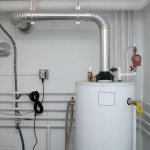As much as we hate to say it, summer is slowly coming to an end. Be prepared for the fall season with these easy tips for preparing your home for fall.
1. Defence against drafts
A home with air leaks around windows and doors can get drafty and keeps the heating costs high. In your annual fall defence, re-caulk and weatherstrip your doors and windows. Test weatherstripping by closing a door or window on a piece of paper; if the paper slides out easily, your weatherstripping isn’t doing its job.
2. Drape away drafts
Even after you’ve weatherstripped and caulked them, windows in older homes can still be drafty. Here’s another line of defence against the chills: window treatments.
The right shades, curtains, and even blinds will help retain some portion of the estimated 10 to 30 percent of heat lost through windows in the wintertime. Install window shades and you’ll also gain control of natural light.
3. Maintain your washer and dryer
Left unattended, a burst washing machine hose can spill hundreds of gallons of water an hour. Likewise, a dryer can erupt in flames if lint is allowed to build up inside the machine or its ducts.
Preventing these mishaps is as easy as replacing a washer’s old rubber hoses, ideally with steel-jacketed ones that can’t split open. Or discard the dryer’s flimsy—and flammable—vinyl duct and put a metal one in its place.
4. Get on top of roof problems
Once a leak has started, it becomes a daunting and timely task to find the source of the leak. Getting on top of roof issues before the winter months can prevent a disaster. Inspect your roof thoroughly. Check for damaged shingles and metal flashing in valleys and around vents and chimneys. Get a ladder and inspect your rain gutters for large accumulations of granules, which can be a sign that your roof is losing its coating. While you’re at it, inspect your gutters for clogs and make sure they’re flowing properly to avoid freeze ups.
5. Give your furnace a physical
Its a good idea to have your heating system inspected by a professional. To avoid disaster in the middle of winter, there are signs that you should have an inspection performed sooner than later. Some signs include noisey belts, poor performance or erratic behavior.
6. Gather around the fire
Inspect your flue for creosote. Creosote is a flammable by-product of burning wood. If it accumulates in a flue or chimney, the result can be a devastating fire. Have your chimney inspected annually for creosote buildup. If you use a fireplace or wood stove frequently, have the flue inspected after each cord of wood burned.
For most people, the best option is to have your entire chimney system inspected by a chimney sweep. Once you know what to look for, you can perform the inspection by shining a bright flashlight up the flue, looking for any deposits approaching 1/8 inch thick. These deposits should be cleaned by an experienced chimney sweep.
Look for flue blockages. Birds love to nest at the top of an unprotected flue. A chimney cap can prevent this from happening. If you don’t have a cap, look up the flue to ensure that there are no obstructions.
Exercise the damper. The damper is the metal plate that opens and closes the flue just above the firebox. Move it to the open and closed positions to ensure that it’s working properly.
Check your chimney for damage. Make certain that the flue cap (the screen or baffle covering the top of the chimney) is in place. Inspect brick chimneys for loose or broken joints. If access is a problem, use binoculars.
7. Detectors
Check and test your smoke and carbon monoxide detectors. Check them by holding the test button or placing a candle near the detector to see if they go off. Your home should have a detector on every floor of your home.
8. Fire extinguishers
Every home should have a fire extinguisher ready at all times, especially at the cottage, where older wood and appliances are more common. When purchasing a fire extinguisher, look for one that is rated for all fire types, and is large enough to extinguish a small fire. At minimum, have one near the kitchen, but one on each floor is a safe investment. When doing annual checkups, make sure the pin is intact, and that the fire extinguisher hasn’t been fired. Have the extinguisher looked over for clogs in the nozzle, dents in the cylinder or corrosion. Replace it if the damage seems severe. Fire extinguishers should be replaced every five years.
9. Crack down on foundation and driveway cracks
Inspect your walkway, driveway and foundation for cracks. Being aware of small cracks and taking care of them before the winter months can save you the hassle of filling a large crack when the spring comes. During cold weather, moisture can seep into these areas and freeze, causing surfaces to crack and split. Most cracks smaller than one inch can be fixed at home, but its always safe to have a professional give you their expertise.
10. Plumbing
There are few things worse than burst pipes in the winter. This is due to pipes freezing and expanding, causing the pipes to crack and leak. Its a good idea to schedule plumbing inspections before winter sets in and repairs become a larger task.




